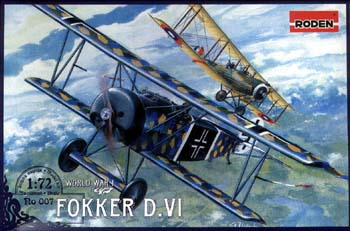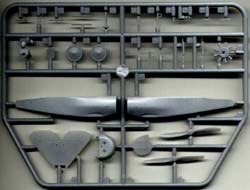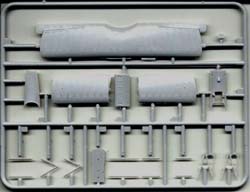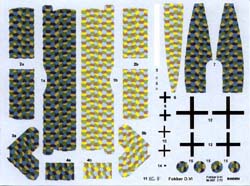 Roden 1/72nd
Fokker D.VI
Roden 1/72nd
Fokker D.VI
By Peter Mitchell
HISTORY
At the Adlershof (Berlin) fighter trials conducted in January 1918, Anthony Fokker entered several prototypes in the hope of acquiring at least one production contract. One of his entries in the rotary engine division was to become the Fokker DVI. Looking somewhat like a combination of the Dr.I and the DVII, this handsome little aircraft was intended as the stop-gap in case the D.VII failed. While it performed well at the trials it was definitely overshadowed by the performance of its stable-mate the Fokker DVII. Produced in limited numbers, it found its way into only a few Jastaschule (fighter schools) and home defence units before the armistice.
THE KIT
 Moulded
in the usual light grey plastic common to the Toko range of kits, this
kit features 48 parts, some quite delicately moulded. There is a bit of
'flash' but this is in the main confined to the larger pieces such as
the wings. In general the surface details are well done, the wings featuring
a nicely represented rib detail, although the fine fabric texture (a feature
common to the Toko kits) would best be removed with a light sanding. I'm
not sure about the triangular leading edge overlay detail that seems more
appropriate to the fabric covering method used on a DrI.
Moulded
in the usual light grey plastic common to the Toko range of kits, this
kit features 48 parts, some quite delicately moulded. There is a bit of
'flash' but this is in the main confined to the larger pieces such as
the wings. In general the surface details are well done, the wings featuring
a nicely represented rib detail, although the fine fabric texture (a feature
common to the Toko kits) would best be removed with a light sanding. I'm
not sure about the triangular leading edge overlay detail that seems more
appropriate to the fabric covering method used on a DrI.
The kit utilises a sprue in common with the Dr.I kit. This contains the parts for the fuselage, cockpit interior, engine, cowling, choice of props and the tail plane, so Bob.ís comments on these items featured in the Roden Dr.I kit also apply here. The other sprue contains the D.VI wings, top fuselage decking, struts and undercarriage.
 Comparison
of the kit parts to drawings contained in the Windsocks .Great War Classics
in profile Vol 1., shows that both upper and lower wings, fuselage and
tail-plane are 'spot on' dimension wise. However the elevators are perhaps
a little short in chord (a compromise for using the Dr'I parts). The fuselage
front decking is well done, possessing some nicely moulded gun mounts,
ammunition feeds and cowled fuel gauge. The rear deck however, may be
a slight problem, either the tailplane is 2mm too far forward or the cockpit
aperture is 2mm too far back, only construction will tell. Either way
this fault shouldn't be hard to correct.
Comparison
of the kit parts to drawings contained in the Windsocks .Great War Classics
in profile Vol 1., shows that both upper and lower wings, fuselage and
tail-plane are 'spot on' dimension wise. However the elevators are perhaps
a little short in chord (a compromise for using the Dr'I parts). The fuselage
front decking is well done, possessing some nicely moulded gun mounts,
ammunition feeds and cowled fuel gauge. The rear deck however, may be
a slight problem, either the tailplane is 2mm too far forward or the cockpit
aperture is 2mm too far back, only construction will tell. Either way
this fault shouldn't be hard to correct.
A large decal sheet is included and this provides four-colour lozenge for the fuselage, wings and tailplane, stencils and national insignia. The colour tones of the lozenge are very dubious (I'd be replacing them) and my sheet was slightly out of register.
 There
is a choice of markings for three machines, two similar black and white
striped ones from Jasta 80b, including Lt
Spiedels. The last choice is for an unidentified DVI in French hands
post-armistice. This features large areas on the fuselage in 'Fokker turquoise'
(a photo of this machine and Lt Spiedel's is to be found in Windsocks
'Great War Classics in profile Vol 1').
There
is a choice of markings for three machines, two similar black and white
striped ones from Jasta 80b, including Lt
Spiedels. The last choice is for an unidentified DVI in French hands
post-armistice. This features large areas on the fuselage in 'Fokker turquoise'
(a photo of this machine and Lt Spiedel's is to be found in Windsocks
'Great War Classics in profile Vol 1').
CONCLUSION
Overall this kit is up to the fine standard set by the Toko range that preceded them. It is accurate where it counts and easily corrected were it isn't. While it may not possess the finesse of some of the recent Eduard 1/72 releases, itís not far behind them. I think that itís fantastic that Roden are continuing the 'ěToko tradition' of producing quality kits of some of the more unusual WWI types. With a minimum of work it will make into an excellent little model.




